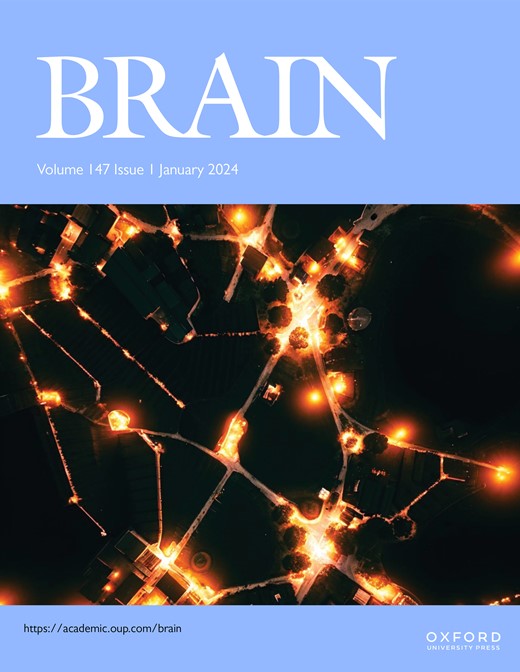Biallelic LGI1 and ADAM23 variants cause hippocampal epileptic encephalopathy via the LGI1–ADAM22/23 pathway
IF 11.7
1区 医学
Q1 CLINICAL NEUROLOGY
引用次数: 0
Abstract
Monoallelic pathogenic variants in LGI1 cause autosomal dominant epilepsy with auditory features with onset in childhood/adolescence. LGI1 is a secreted neuronal protein, functions as a ligand for ADAM22/23, and regulates excitatory synaptic transmission and neuronal excitability in the brain. While biallelic ADAM22 variants cause developmental and epileptic encephalopathy (DEE), the whole picture of LGI1–ADAM22/23 pathway-related diseases remains incompletely understood. Through international genetic data sharing, we identified the first ultra-rare biallelic LGI1 variants in six individuals from four consanguineous families. Affected individuals presented DEE with neonatal/infantile-onset epilepsy (6/6), global developmental delay/intellectual disability (6/6), and infant/premature death (5/6). Brain MRI showed mild cerebral atrophy in a subset of patients (3/6). Functional analyses revealed that all LGI1 variants result in reduced secretion and ADAM22-binding. Residual LGI1 function levels correlated with clinical severity, ranging from infantile lethality to intermediate phenotypes. Further, we observed epileptic discharges from the isolated whole hippocampus of Lgi1–/– knockout mice, experimentally modelling the hippocampal origin of LGI1-related epilepsy. Automated behavioural analysis of a mouse model for ADAM22-related DEE revealed its impaired cognitive function. Furthermore, we report the first ADAM23 variant associated with lethal neonatal-onset epilepsy and myopathy. Collectively, this study defines the LGI1–ADAM22/23 pathway-related disease spectrum.双等位基因LGI1和ADAM23变异通过LGI1 - adam22 /23通路引起海马癫痫性脑病
LGI1的单等位致病变异导致常染色体显性癫痫,伴有听觉特征,发病于儿童/青春期。LGI1是一种分泌性神经元蛋白,作为ADAM22/23的配体,调节脑内兴奋性突触传递和神经元兴奋性。虽然双等位基因ADAM22变异导致发育性和癫痫性脑病(DEE),但LGI1-ADAM22/23通路相关疾病的全貌仍不完全清楚。通过国际遗传数据共享,我们在来自四个近亲家庭的六个人中发现了第一个超罕见的双等位基因LGI1变异。受影响的个体表现为新生儿/婴儿癫痫(6/6),整体发育迟缓/智力残疾(6/6)和婴儿/过早死亡(5/6)。脑MRI显示部分患者出现轻度脑萎缩(3/6)。功能分析显示,所有LGI1变异都导致分泌减少和adam22结合减少。残留的LGI1功能水平与临床严重程度相关,范围从婴儿致死率到中间表型。此外,我们观察了Lgi1 - / -敲除小鼠的离体整个海马的癫痫放电,实验模拟了Lgi1相关癫痫的海马起源。adam22相关DEE小鼠模型的自动行为分析显示其认知功能受损。此外,我们报告了首个与新生儿致死性癫痫和肌病相关的ADAM23变异。总的来说,本研究定义了LGI1-ADAM22/23通路相关的疾病谱系。
本文章由计算机程序翻译,如有差异,请以英文原文为准。
求助全文
约1分钟内获得全文
求助全文
来源期刊

Brain
医学-临床神经学
CiteScore
20.30
自引率
4.10%
发文量
458
审稿时长
3-6 weeks
期刊介绍:
Brain, a journal focused on clinical neurology and translational neuroscience, has been publishing landmark papers since 1878. The journal aims to expand its scope by including studies that shed light on disease mechanisms and conducting innovative clinical trials for brain disorders. With a wide range of topics covered, the Editorial Board represents the international readership and diverse coverage of the journal. Accepted articles are promptly posted online, typically within a few weeks of acceptance. As of 2022, Brain holds an impressive impact factor of 14.5, according to the Journal Citation Reports.
 求助内容:
求助内容: 应助结果提醒方式:
应助结果提醒方式:


